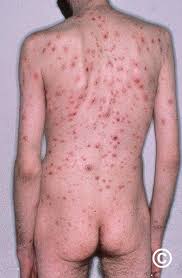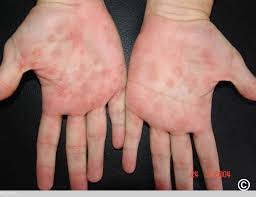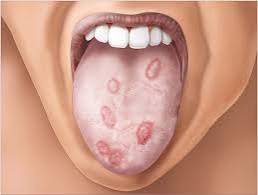

 Secondary syphilis is a stage of syphilis, a sexually transmitted infection caused by the bacterium Treponema pallidum.
Secondary syphilis is a stage of syphilis, a sexually transmitted infection caused by the bacterium Treponema pallidum.
Secondar stage syphilis typically occurs several weeks to a few months after the initial infection.
The initial infection is characterized by a primary chancre at the site of inoculation.
Secondary syphilis has a wide array of clinical manifestations.
Its most common presentation includes a polymorphic rash that often involves the palms and soles, mucocutaneous lesions, and generalized lymphadenopathy.
Other systemic symptoms that may occur can include fever, malaise, weight loss, and myalgia.
The rash of secondary syphilis can be macular, papular, or pustular.
The rash may be accompanied by mucous patches in the oral cavity or condylomata lata in the anogenital region.
Less common clinical findings include alopecia, hepatitis, nephrotic syndrome, and ocular or neurological involvement.
Diagnosis is typically confirmed through serologic testing, including non-treponemal tests such as the Rapid Plasma Reagin (RPR) and treponemal tests like the Treponema pallidum hemagglutination assay (TPHA)
Histopathological biopsy examination may reveal plasma cell infiltrates and necrotic keratinocytes.
Treatment for secondary syphilis generally involves a single intramuscular injection of benzathine penicillin G (2.4 million units).
